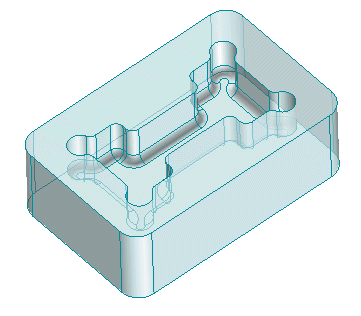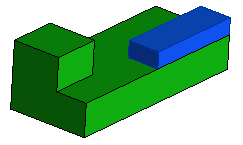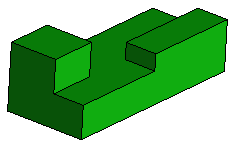Common mistakes when using Booleans
Considering the great variety of functions offered by the think3 application, the following example shows you a common mistake in solid modeling: the excessive use of Boolean operations while features would be much more effective and easy to use.
You might often be tempted to use Boolean operations to perform simple tasks without considering that this might make the model history too complex, thus reducing your control over the individual processing phases.
This is particularly true if you consider the new features now offered by the think3 application, such as linear protrusion/slot with fillet and Smart Shapes.
For example, in order to create a cavity with fillets, as shown in the example below:

You do not need to create a separate solid and then subtract it.

On the contrary, it is advisable to use features to perform this task. In this case, for example, you can use a single feature, the Linear Protrusion with Fillet/Chamfer feature, which allows you to insert the fillet at the same time of the protrusion.
Disadvantages and side effects
Let's see which could be the disadvantages and the side effects of using too many Booleans instead of the more appropriate features:
- It can be difficult to change the order inside processing, particularly if you need to change the order (or move inside the Model Structure) of features. A Boolean operation makes the Model Structure of a model extremely complex, therefore also movements inside the history become complex. Just consider that a Boolean operation between n solids involves n branches in the Model Structure.
- You can perform no pattern operation on the parts of a solids generated by means of a Boolean operation. For example, if you add a pocket by subtracting a solid you will not be able to perform a pattern operation on that pocket. If a pattern is needed, it has to be executed before the Boolean operation. But if you create the pocket using the Slot feature, you do not have the same problem.
- No mirror operation can be performed on the parts of a solid generated by means of a Boolean operation, for the same reasons described above.
- You cannot assign a variable to an event generated by a Boolean operation, while you can control a feature assigning a variable to it.
- You cannot immediately remove the processing operations resulting from Boolean operations. You must first of all isolate them and remove them from the model. Furthermore, if the Boolean event is not a single event but the combination of more events, the dismantling process can be even more time consuming.
In the example below, three solids have been inappropriately grouped using a Boolean Union operation instead of a linear protrusion. If you unite first of all the green solid and the red solid, and then the resulting object with the blue solid, you generate a set of concatenated events which can reduce your control over the single parts (if you want to remove one of the parts, for example). If you want to remove the red part, for instance, you must first of all "undo" the union event with the blue solid.



Related Materials




